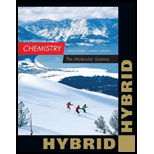
Interpretation:
The volume of
Concept Introduction:
The performance of an engine or fuel is measured in terms of octane number or octane rating. The processes that are used to increase the octane number of a fuel are known as catalytic cracking and catalytic reforming. Catalytic reforming converts the straight chain hydrocarbon into the branched hydrocarbon.
Answer to Problem 98QRT
The volume of
Explanation of Solution
The amount of fuel that is
The relation between gallon and liters is as follows.
Conversion of
The density of
The relation between volume and mass is shown below.
Substitute the density and volume of
The molar mass of
Substitute the mass and molar mass of
The combustion of one mole of
Therefore, the number of moles of
The volume of
Want to see more full solutions like this?
Chapter 10 Solutions
Chemistry: The Molecular Science, Hybrid Edition (with OWLv2 24-Months Printed Access Card)
- How many kilograms of CO2 are produced by the complete combustion of 3.8 kg of n-octane?arrow_forwardDo hydrocarbons consistently produce more energy than oxygenated fuels like ethanol or vice versa?arrow_forwardHow many kilograms of CO2 does the complete combustion of3.8 kg of n-octane produce?arrow_forward
- (a) When the metallic element sodium combines with the nonmetallic element bromine, Br2(l), how can you determine the chemical formula of the product? How do you know whether the product is a solid, liquid, or gas at room temperature? Write the balanced chemical equation for the reaction. (b) When a hydrocarbon burns in air, what reactant besides the hydrocarbon is involved in the reaction? What products are formed? Write a balanced chemical equation for the combustion of benzene C6H6(l), in air.arrow_forwardConsider methane, CH₄, and hydrogen, H₂, as possible fuel sources a. Describe how methane and hydrogen could be obtained. Which of these methods do you think is less expensive? Explain. b. Which fuel do you think is more environmentally friendly? Explain.arrow_forward1. Write equations for the substitution of hydrogen by bromine in methane.2. Write the reaction for the combustion of ethane.arrow_forward
- What hydrocarbons enter the atmosphere from internal combustion engines? A. Carboxylics B. Alkynes C. Alkenes D. Alkyl hydrocarbonsarrow_forwardCalculate the amount of heat released during the combustion of: a. 0.30 mol of C3H6O b. 100 g of C3H6Oarrow_forwardComplete and balance the following combustion reactions. Assume that each hydrocarbon is converted completely to carbon dioxide and water. (a) Propane + O2 (b) Octane + O2 (c) Cyclohexane + O2 (d) 2-Methylpentane + O2arrow_forward
 Chemistry: The Molecular ScienceChemistryISBN:9781285199047Author:John W. Moore, Conrad L. StanitskiPublisher:Cengage Learning
Chemistry: The Molecular ScienceChemistryISBN:9781285199047Author:John W. Moore, Conrad L. StanitskiPublisher:Cengage Learning Chemistry & Chemical ReactivityChemistryISBN:9781337399074Author:John C. Kotz, Paul M. Treichel, John Townsend, David TreichelPublisher:Cengage Learning
Chemistry & Chemical ReactivityChemistryISBN:9781337399074Author:John C. Kotz, Paul M. Treichel, John Townsend, David TreichelPublisher:Cengage Learning Organic ChemistryChemistryISBN:9781305580350Author:William H. Brown, Brent L. Iverson, Eric Anslyn, Christopher S. FootePublisher:Cengage Learning
Organic ChemistryChemistryISBN:9781305580350Author:William H. Brown, Brent L. Iverson, Eric Anslyn, Christopher S. FootePublisher:Cengage Learning Introductory Chemistry: An Active Learning Approa...ChemistryISBN:9781305079250Author:Mark S. Cracolice, Ed PetersPublisher:Cengage Learning
Introductory Chemistry: An Active Learning Approa...ChemistryISBN:9781305079250Author:Mark S. Cracolice, Ed PetersPublisher:Cengage Learning Chemistry & Chemical ReactivityChemistryISBN:9781133949640Author:John C. Kotz, Paul M. Treichel, John Townsend, David TreichelPublisher:Cengage Learning
Chemistry & Chemical ReactivityChemistryISBN:9781133949640Author:John C. Kotz, Paul M. Treichel, John Townsend, David TreichelPublisher:Cengage Learning Introductory Chemistry: A FoundationChemistryISBN:9781285199030Author:Steven S. Zumdahl, Donald J. DeCostePublisher:Cengage Learning
Introductory Chemistry: A FoundationChemistryISBN:9781285199030Author:Steven S. Zumdahl, Donald J. DeCostePublisher:Cengage Learning





